Hello & Goodbye LEGO® VIDIYO
When LEGO announced VIDIYO, it was heralded as the next big thing in Augmented Reality (AR) in January of 2021 I was intrigued. Cautiously intrigued. To be honest I should probably say wearily intrigued. There is something about big announcements from LEGO about new breakthrough technology that makes me feel a little anxious. It is not that I am a luddite. I love technology, and I came out of my dark ages through MINDSTORMS. But when it comes to new endeavours around combining bricks and digital play, I haven’t had the best experiences. Or I simply didn’t get it.
Not to go too far back, the previous sortie into AR was called Hidden Side. It would be unfair to say that I gave that theme a completely unbiased and fair chance. Hidden Side was about hunting ghosts and that is simply not something I enjoy or even feel comfortable about. It did not prevent me from keeping an eye on what happened around the platform and what the feedback from the community was. All in all, the impression I got was that while many of the physical builds were quite interesting, the added incentive of the AR environment – being able to hunt the ghosts by viewing the sets through your smart device – had some serious challenges. Those ranged from the set needing to stay exactly as portrayed in the instructions (so no serious modifications allowed) to the app being very demanding in terms of hardware requirements. Hidden Side was released in the first half of 2019 and discontinued the year after.
LEGO offering a new AR experience hopefully meant that lessons were learned from the previous experience. LEGO had been dropping hints of a big collaboration with a large record label and, being a musician myself, that had my curiosity piqued. I’ve been around long enough not to get swept away by the hype LEGO was trying to create about it (and honestly, who is this L.L.A.M.A. person anyway?) but the idea of creating a band using LEGO figures and recording videoclips, there just might be something in it. My kids were bedazzled by the bright colours, the luxurious prints, and the cute form factor of the beat boxes and so a couple of them landed in our collection, just to get a feel of what this new product was all about.
First impressions
The form factor of the cardboard boxes the Beat Boxes came in already made the product feel different. Somehow, we associate LEGO to rather flat oblong boxes so the cube shape, highlighting the AR factor of the sets, already created a bit of extra anticipation.

Candy Mermaid box front.
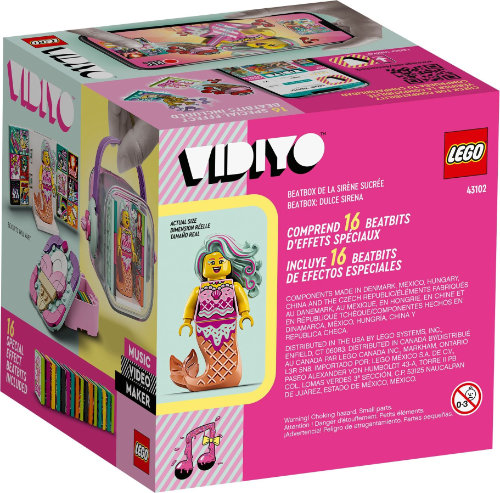
Candy Mermaid box back.
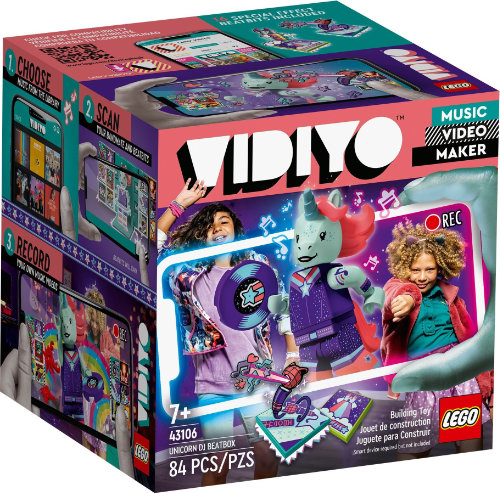
Unicorn DJ box front.

Unicorn DJ box back.
The boxes contained a number of new large elements to create the container that will both carry the minifigure and serve as a stage to perform on. In addition, there were a generous number of 2x2 tiles with printed patterns called “beat bits”.
The flow of these sets is easily described with a few images.
Step 1: build the box
Although the box itself is put together with a very small number of elements, the cover on the rear comes with a sufficient number of small tiles to create different decorative patterns in the style of the set character.
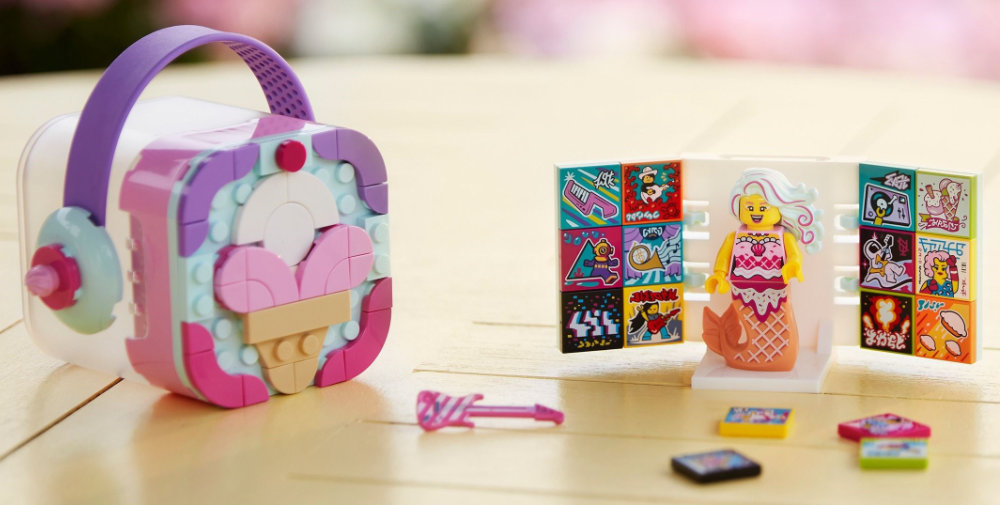
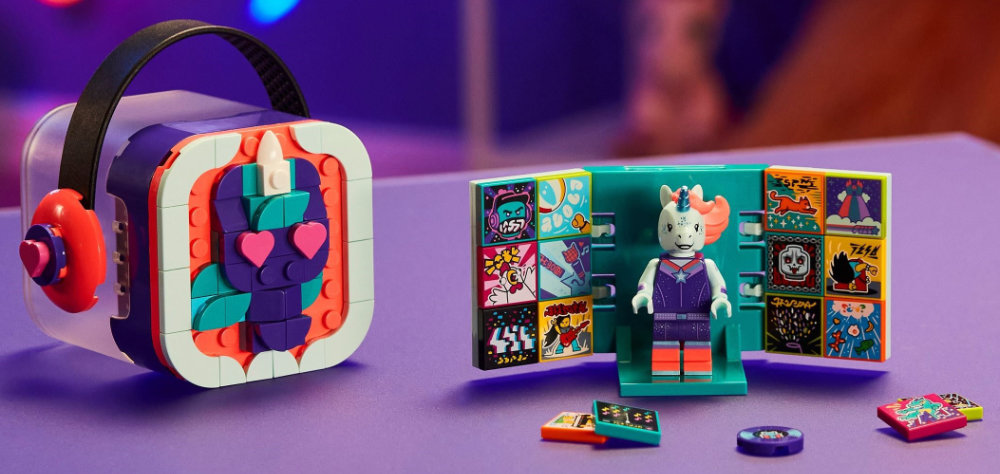
Step 2: select your beat bits
Each beat bit can trigger a different kind of action during game play. There are no instructions so you have to try them out and remember what each one does. Some create sounds, other actions and there are also those that trigger things like streamers or flying unicorns. Some idea of what to expect is already visible on the box and in the images provided by LEGO.
Cherry ice-cream and a brass effect.
A flying castle and a singing microphone.
Further ideas of how this will integrate with the AR game are shown through app screen illustrations. Unfortunately the app itself is so locked down (presumably because of copyright issues and in an effort to safeguard the privacy of the kids playing with it) that it is impossible to take screenshots of anything – except if you are taking actual photographs with a second device.
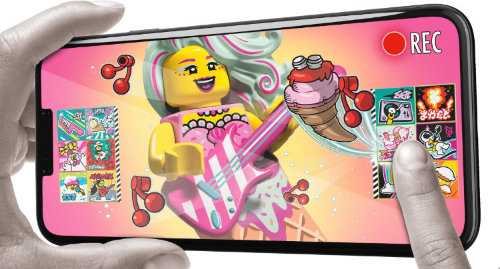
Illustration of gameplay with the Mermaid.
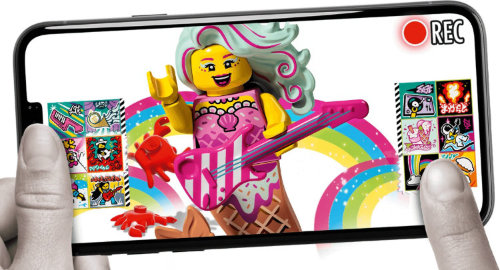
Rainbow effect a go!.
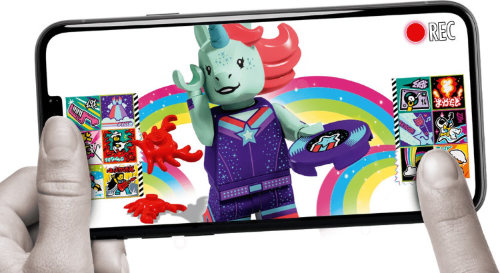
More rainbows.
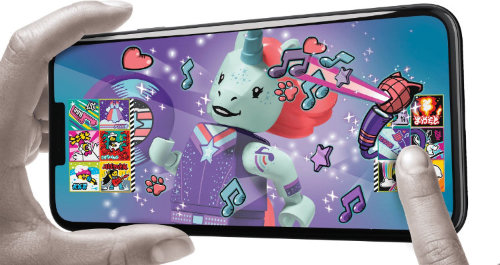
Unicorn DJ uses the mic.
The selected beatbits – 12 out of a total of 16 included in each set – are added to the stage depending on the effects you want to have available for your AR session.
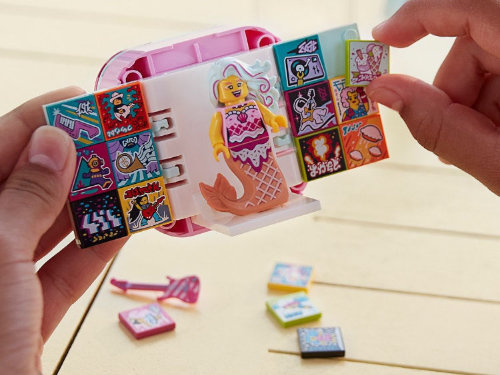
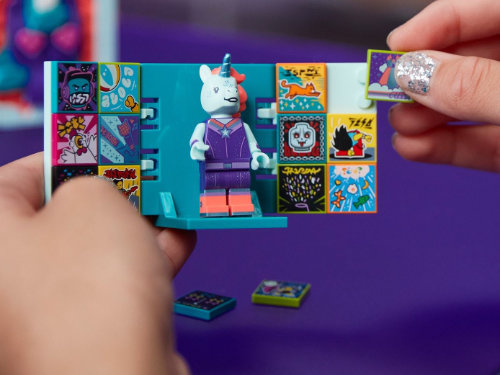
Step 3: play
This is where the fun begins… or that’s how things were planned. But let’s not get ahead of ourselves. In theory, after building the set and selecting the desired beatbits, it is time to fire up the app, scan the scene and record a musical video, as illustrated in the next picture:
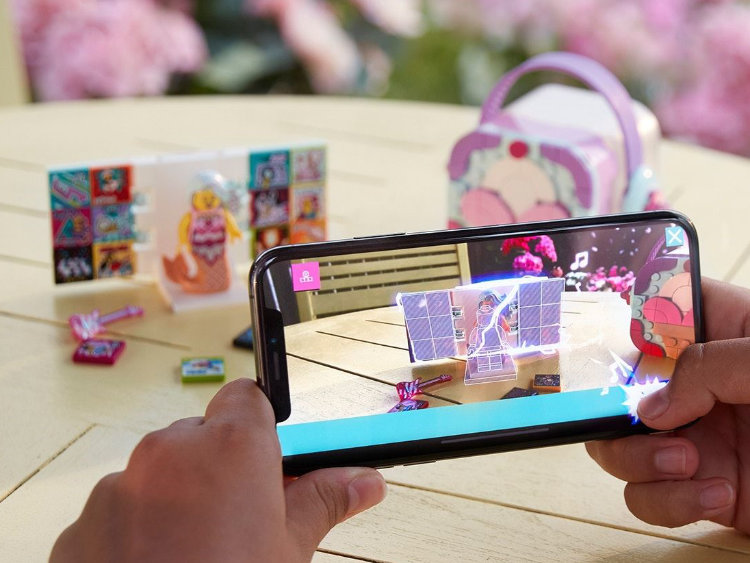
In theory I say, because in practice things were a little more complex. For starters, AR is a technology that is still pretty new and has important hardware requirements. The devices kids in the intended age range tend to use are often hand-me downs from older siblings or parents or low end devices as their day-to-day requirements (and allowed use) are normally quite low. Running the Vidiyo app with any kind of smooth experience requires a more powerful device and so many kids needed to get their parents to lend them their devices – and parents are not going to lend those too often nor for extended periods.
A second obstacle was the app itself. Especially in the beginning stages it was incredibly confusing and slow to use. My tech-savvy eleven-year-old daughter (who din’t have any devices capable of running the Vidiyo software) borrowed my phone and had a serious go at it. After installing a sizable app, the first thing that was required after opening it was… downloading more content. This cycle of “wait I need this” and “wait I need that” from the app itself was a major source of frustration.
Next up was the process of getting set up. We needed to choose a band name. Choose is probably the wrong word. Choosing would have been easy. We needed to select an acceptable option from the list of suggestions. If you finally saw an option that wasn’t quite as bad as the ones that had been proposed so far, but wanted to see what else was possible, that particular option would never ever come back again – it was lost in the sea of randomly generated gibberish.
Then it was time to create the first video, so we got everything set up and ready to go. In addition to the beatboxes we got a handful of bandmates too. Again, we ran into the limitations of the app: only three bandmates could ever be used at the same time.
After settling on 3 bandmates, selecting a song (neither my daughter nor I were impressed by the musical choices we were initially offered) and initiating the AR experience it took some figuring out to realise that we needed more space to play in (we had to distance ourselves a lot further from the intended target stage to be able to see enough of the bandmates – not great for small quarters) we more or less succeeded in making the first video.
All this effort led to fatigue and we decided to call it a day. When we tried again the next day we were back to square one: select a band name… Apparently, we had not been enthusiastic enough to keep at it until the app finally decide that our efforts merited saving our progress.
We never made it past day 3.
Looking ahead
The Vidiyo app was optimised, two more waves of bandmates and a bunch of larger sets were added, but the initial idea of creating videos never really caught on. Why? I can think of a number of reasons. One obvious reason is the fact that the app was completely locked down. You could record videos, but never get them off your device. While I can see how something like this might be due to copyright issues and the need to protect under-age children from exposure on the Internet, it completely defeats the purpose the underlying premise. And even with an optimised (or at least more user friendly) app , the hardware requirements were still such that the average kid couldn’t really aspire to use it on their own device. Finally, there was an important disconnect between a kids fantasy and what the app would allow.
Although the strict limitations in changes of the setup seen in Hidden Side were not as actively present in Vidiyo, there is still a lot of room for improvement. You could argue that Vidiyo was a step better than Hidden side in certain aspects, but even so, it was not the success LEGO was hoping for. Maybe the technology simply isn’t ready enough yet. Or maybe LEGO hasn’t really figured out how to do this. It’s probably a bit of both, and as Vidiyo comes to an end I am already slightly apprehensive at what LEGO’s next step on the tortuous road of AR might be. I promise to (try to) give it the benefit of the doubt.
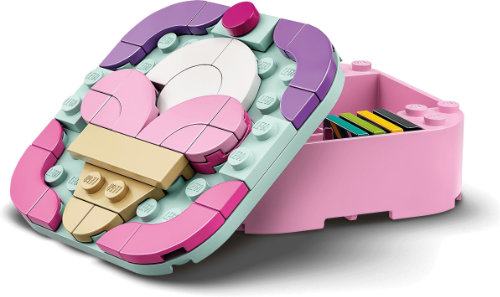
We thank LEGO for supplying us with materials for this review. The opinions in this article are not endorsed or approved by LEGO
33506